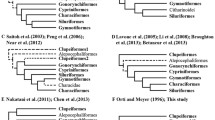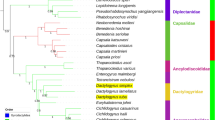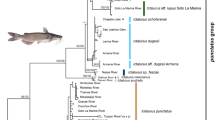Abstract
Much attention has been paid to the molecular phylogeny of holocephalan fishes during recent years, but sampling was very low and not all genera were examined. This study offers an extended sampling of species from all known genera to clarify their phylogeny and to provide an estimate of the time of origin of extant holocephalan taxa. Three mitochondrial genes (cytochrome b, 12S rRNA, and 16S rRNA) were sequenced and analysed using a variety of phylogenetic methods (Bayes, maximum likelihood, and maximum parsimony). Callorhinchidae diverged from Rhinochimaeridae and Chimaeridae about 187 Ma ago. Chimaeridae and Rhinochimaeridae diverged from each other about 159 Ma ago. Within Rhinochimaeridae, Neoharriotta is the sister genus to the closely related Harriotta and Rhinochimaera. Eight species of the family Chimaeridae, belonging to the genera Hydrolagus and Chimaera, were examined. They probably had a common ancestor about 107 Ma ago and appear paraphyletic. These results indicate that the traditional morphological generic definition of the families Rhinochimaeridae and Chimaeridae has to be reinvestigated.



Similar content being viewed by others
References
Allis, E. P., Jr. (1917). The prechordal portion of the chondrocranium of Chimaera colliei. Proceedings of the Zoological Society of London, 1917, 105–143.
Allis, E. P., Jr. (1926). On the homologies of the prechordal portion of the skull of the holocephali. Journal of Anatomy, 60, 335–340.
Arnason, U., Gullberg, A., & Janke, A. (2001). Molecular phylogenetics of gnathostomous (jawed) fishes: Old bones, new cartilage. Zoologica scripta, 30(4), 249–255.
Benton, M. J., & Donoghue, P. C. J. (2007). Paleontological evidence to date the tree of life. Molecular Biology and Evolution, 24, 26–53.
Benton, M. J., Donoghue, P. C. J., & Asher, R. J. (2009). Calibrating and constraining molecular clocks. In: S. B. Hedges & S. Kumar (eds.), The time tree of life (pp. 35–86). Oxford University Press.
Bigelow, H. B., & Schroeder, W. C. (1951). Three new skates and a new chimaeroid fish from the Gulf of Mexico. Journal of the Washington Academy of Science, 41, 390.
Bleeker, P. (1854). Nieuwe nalezingen op de ichthyologie van Japan. Verhandelingen van het Bataviaasch Genootschap van Kunsten en Wetenschappen, 26, 1–132.
Botella, H., Valenzuela-Ríos, J. I., & Martínez-Pérez, C. (2009). Tooth replacement rates in early chondrichthyans: A qualitative approach. Lethaia, 42, 365–376.
Broili, F. (1933). Weitere Fische aus den Hunsrückschiefern. Sitzungsberichten der Bayerischen Akademie der Wissenschaften, 1933, 269–313.
Cole, F. J. (1896a). The cranial nerves of Chimaera monstrosa. Proceedings of the Royal Society of Edingburgh, 21, 49–56.
Cole, F. J. (1896b). On the sensory and ampullary canals of chimaera. Anatomischer Anzeiger, 12, 172–182.
Cole, F. J. (1896c). On the cranial nerves of Chimaera monstrosa (Linn. 1754); with a discussion of the lateral line system, and of the morphology of the chorda tympani. Transactions of the Royal Society of Endingburgh, 38, 631–680.
De Beer, G. R., & Moy-Thomas, J. A. (1935). On the Skull of Holocephali. Philosophical Transactions of the Royal Society B, Biological Sciences, 224, 287–312.
Bory de Saint, J. B. (1823). Dictionaire classique d`histoire naturelle, vol. 3. Paris, p. 62.
Dean, B. (1906). Chimaeroid fishes and their development. Carnegie Institution of Washington, 32.
Dean, B. (1909). Studies on fossil fishes (Sharks, Chimaeroids and Arthrodires). Memoirs of the American Museum of Natural History, 9, 211–287.
Didier, D. A. (1987). Myology of the pectoral, branchial, and jaw regions of the ratfish Hydrolagus colliei (Holocephali). Senior honor Thesis, Biology Department, Illinois Wesleyan University. pp. 40.
Didier, D. A. (1995). Phylogenetic systematics of extant chimaeroid fishes (Holocephali, Chimaeroidei). American Museum Novitates, 3119, 1–86.
Didier, D. A. (2004). Phylogeny and classification of extant holocephali. In J. C. Carrier, J. A. Musick, & M. R. Heithanus (Eds.), Biology of sharks and their relatives (pp. 115–135). London, UK: CRC Press.
Didier, D. A., & Rosenberger, L. J. (2002). The Spotted Ratfish, Hydrolagus colliei: Notes on its Biology with a Redescription of the species (Holocephali: Chimaeridae). California Fish and Game, 88, 112–125.
Didier, D. A., Last, P. R., & White, W. T. (2008). Three new species of the genus Chimaera Linnaeus (Chimaeriformes: Chimaeridae) from Australia. CSIRO Marine and Atmospheric Research Paper, 22, 327–340.
Donovan, E. (1808). The natural history of British fishes, including scientific and general descriptions of the most interesting species, and an extensive selection of accurately finished coloured plates. London: 1-516.
Douady, C. J., Dosay, M., Shivji, M. S., & Stanhope, M. J. (2003). Molecular phylogenetic evidence refuting the hypothesis of Batoidea (rays and skates) as derived sharks. Molecular Phylogenetic and Evolution, 26, 215–221.
Drummond, A. J., & Rambaut, A. (2007). beast: Bayesian evolutionary analysis by sampling trees. BMC Evolutionary Biology, 7, 214.
Drummond, A. J., Ho, S. Y. W., Phillips, M. J., & Rambaut, A. (2006). Relaxed phylogenetics and dating with confidence. PLoS Biology, 4(5), e88. doi:10.1371/journal.pbio.0040088.
Duffin, C. J. (2001). A chimaerid (Holocephali, Chimaeriformes) vomerine toothplate from the Upper Cretaceous of Belgium. Palaeontology, 44(6), 1179–1188.
Duméril, A. H. A. (1865). Histoire naturelle des poissons ou ichthyologie générale. Tome Premier. Elasmobranchés. Plagiostomes et Holocéphales ou Chimères. Librairie Encyclopédique de Roret, Paris. 720 pp.
Felsenstein, J. (1985). Confidence limits on phylogenies: An approach using the bootstrap. Evolution, 39, 783–791.
Fowler, H. W. (1910). Notes on chimaeroid and ganoid fishes. Proceedings of the Academy of Natural Sciences of Philadelphia, 62, 603–612.
Gilchrist, J. D. F. (1922). Deep-sea fishes procured by the S.S. Pickle. Part 1. Report Fisheries and Marine Biological Survey, Union of South Africa 2, special report 3, 41-79.
Gill, T. (1898). Families and subfamilies of fishes. National Academy of Sciences Memoirs, 6, 127–138.
Goode, G. B., & Bean, T. H. (1895). On Harriotta, a new type of chimaeroid fish from the deeper waters of the northwestern Atlantic. Proceedings of the United States National Museum, 17(1014), 471–473.
Grogan, E. D., Lund, R., & Didier, D. A. (1999). Description of the chimaerid jaw and its phylogenetic origins. Journal of Morphology, 239, 45–59.
Heinicke, M. P., Naylor, G. J. P., & Hedges, S. B. (2009). Cartilaginous fishes (Chondrichthyes). In S. B. Hedges & S. Kumar (Eds.), The timetree of life (pp. 320–327). New York, NY: Oxford University Press.
Helfman, G. S., Collette, B. B., Facey, D. E., & Bowen, B. W. (2009). The diversity of fishes (2nd ed.). Oxford, UK: Wiley-Blackwell.
Ho, S. Y. W., & Larson, G. (2006). Molecular clocks: When times are a-changin´. Trends in Genetics, 22, 79–83.
Holmgren, N. (1942). Studies on the head of fishes. Part III. The phylogeny of Elasmobranch fishes. Acta Zoologica, 23, 129–261.
Hubrecht, A. A. W. (1877). Beitrag zur Kenntniss des Kopfskeletes der Holocephalen. Niederländisches Archiv für Zoologie, 3, 255–276.
Huelsenbeck, J. P., & Ronquist, F. (2001). MrBayes: Bayesian inference of phylogenetic trees. Bioinformatics, 17, 754–755.
Inoue, J. G., Miya, M., Lam, K., Tay, B. H., Danks, J. A., Bell, J., Walker, T. I., & Venkatesh, B. (2010). Evolutionary origin and phylogeny of the modern holocephalans (Chondrichthyes: Chimaeriformes): A mitogenomic perspective. Molecular Biology and Evolution, 27(11), 2576–2586.
Jordan, D. S., & Snyder, J. O. (1900). A list of fishes collected in Japan by Keinosuke Otaki, and by the United States Fish Commission steamer “Albatross”, with description of fourteen new species. Proceedings of the United States National Museum, 23, 335–380.
Klug, S. (2010). Monophyly, phylogeny and systematic position of the Synechdontiformes (Chondrichthyes, Neoselachii). Zoologica Scripta, 39(1), 37–49.
Kumar, S., Tamura, K., & Nei, M. (2004). MEGA3: Integrated software for Molecular Evolutionary Genetics Analysis and sequence alignment. Briefings in Bioinformatics, 5, 150–163.
Lay, G. T., & Bennett, E. T. (1839). Fishes. In J. Richardson, N. A. Vigors, G. T. Lay, W. Buckland, & G. B. Soerby (Eds.), The zoology of Captain Beechey`s voyage (pp. 41–75). London: Henry G. Bohn.
Le, H. L. V., Lecointre, G., & Perasso, R. (1993). A 28S rRna-based phylogeny of the Gnathostomes: First steps in the analysis of conflict and congruence with morphological based cladograms. Molecular Phylogenetics and Evolution, 2(1), 31–51.
Letsch, H. O., & Kjer, K. M. (2011). Potential pitfalls of modelling ribosomal RNA data in phylogenetic tree reconstruction: Evidence from case studies in metazoa. BMC Evolutionary Biology, 11, 146.
Letsch, H. O., Kück, P., Stocsits, R. R., & Misof, B. (2010). The impact of rRNA secondary structure consideration in alignment and tree reconstruction: simulated data and a case study on the phylogeny of hexapods. Molecular Biology and Evolution, 27(11), 2507–2521.
Leydig, F. (1851). Anatomie und Histologie der Chimaera monstrosa. Müller`s Archiv, 241-271.
Licht, M. (2008). Cranial morphology of Hydrolagus colliei and its bearing on holocephalan phylogeny. Unpublished Diploma-Thesis. University of Göttingen. 57 pp.
Licht, M., & Bartsch, P. (2009). Phylogenetic information from cranium and cranial nerves of chimaeroid fishes. In: Abstractband - VII. Tagung der Gesellschaft für Ichthyologie e.V. (GFI): 1.-3. Oktober 2009 in Hamburg. p.15.
Linnaeus, C. (1758). Systema naturae per regna tria naturæ, secundum classes, ordines, genera, species, cum characteribus, differentiis, synonymis, locis. Tomus I. Editio decima, reformata. [1-4], 1-824. Holmae. (Salvius).
Liu, Z. (2001). Phylogenetic relationships of the living chimaeroid fishes based on characters of the brain and cranial nerves. The New Mexico Journal of Science, 41(1), 1–24.
Lund, R., & Grogan, E. D. (1997). Relationships of the Chimaeriformes and the basal radiation of the Chondrichthyes. Reviews in Fish Biology and Fisheries, 7, 65–123.
Maisey, J. G. (1986). Heads and tails: A cordate phylogeny. Cladistics, 2, 201–256.
Mitsukurii, K. (1895). On a new species of the chimaeroid group Harriotta. Zoological Magazine (Tokio), 7, 97–98.
Müller, J., & Henle, F. G. J. (1841). Systematische Beschreibung der Plagiostomen (pp. 1–200). Veit: Berlin.
Nylander, J. A. A. (2004). MrModeltest 2. Program distributed by the author. Evolutionary Biology Centre, Uppsala University.
Ørvig, T. (1960). New Finds of Acanthodians, Arthrodires, Crossopterygians, Ganoids and Dipnoans in the Upper Middle Devonian Calcareous Flags (Oberer Plattenkalk) of the Bergisch Gladbach-Paffrath Trough. Paläontologische Zeitschrift, 34, 295–335.
Ørvig, T. (1962). Y a-t-il une relation directe entre les arthrodires ptyctodontides et les holocephales? Colloquim International C.N.R.S, 104, 49–61.
Patterson, C. (1965). The Phylogeny of the Chimaeroids. Philosophical Transactions of the Royal Society B, Biological Sciences, 249, 101–219.
Pereira, S. L., & Baker, A. J. (2006). A molecular timescale for galliform birds accounting for uncertainty in time estimates and heterogeneity of rates of DNA substitutions across lineages and sites. Molecular Phylogenetics and Evolution, 38, 499–509.
Rambaut, A., & Drummond, A. J. (2007). Tracer v1.4. available from http://beast.bio.ed.ac.uk/Tracer.
Rasmussen, A. S., & Arnason, U. (1999). Phylogenetic studies of complete mitochondrial DNA molecules place cartilaginous fishes within the tree of bony fishes. Journal of Molecular Evolution, 48, 118–123.
Reuter, J. S., & Mathews, D. H. (2010). RNAstructure: Software for RNA secondary structure prediction and analysis. BMC Bioinformatics, 11, 129.
Schaeffer, B. (1981). The xenacanth shark neurocranium with comments on elasmobranch phylogeny. Bullettin of the American Museum of Natural History, 169, 3–66.
Schaeffer, B., & Williams, M. (1977). Relationships of fossil and living elasmobranches. American Zoologist, 17, 293–302.
Silvestro, D., & Michalak, I. (2011). raxmlGUI: a graphical front-end for RAxML. Organisms, Diversity and Evolution. doi:10.1007/s13127-011-0056-0.
Stahl, B. J. (1967). Morphology and Relationships of the Holocephali with special Reference to the Venous System. Bulletin of the Museum of Comparative Zoology, 135, 141–213.
Stahl, B. J. (1999). Chondrichthyes III Holocephali. In H.-P. Schultze (Ed.), Handbook of Paleoichthyology, Vol. 4 (p. 164). Munich: Verlag Dr. Friedrich Pfeil.
Stamatakis, A. (2006). RAxML-VI-HPC: Maximum likelihood-based phylogenetic analyses with thousands of taxa and mixed models. Bioinformatics, 22, 2688–2690.
Swofford, D. L. (2002). “Paup*: Phylogenetic analysis using parsimony (and other methods)”, version 4.0b10. Sinauer Associates, Sunderland/Massachusetts.
von Schnakenbeck, W. (1929). Über einige Meeresfische aus Südwestafrika. Mitteilungen des Zoologischen Staatsinstituts und Zoologisches Museum Hamburg, 44, 38–45.
Ward, D. J., & Duffin, C. J. (1989). Mesozoic chimaeroids. 1. A new chimaeroid from the Early Jurassic of Gloucestershire, England. Mesozoic Research, 2, 45–51.
Ward, R. D., Zemlak, T. S., Innes, B. H., Last, P. R., & Hebert, P. D. N. (2005). DNA barcoding Australia`s fish species. Philosophical Transactions of the Royal Society B, Biological Sciences, 360, 1847–1857.
Ward, R. D., Holmes, B. H., White, W. T., & Last, P. R. (2008). DNA barcoding Australasian chondrichthyans: Results and potential uses in conservation. Marine and Freshwater Research, 59, 57–71.
Whiteley, G. P. (1939). Taxonomic notes on sharks and rays. Australian Zoologist, 60, 227–262.
Zangerl, R. (1981). Handbook of paleoichthyology, vol. 3A Chondrichthyes I. Palaeozoic Elasmobranchii. New York: Gustav Fischer Verlag.
Acknowledgements
We sincerely thank Matthias Schneider (Frankfurt), Axel Zarske (Dresden), Ralf Thiel (Hamburg), Friedhelm Krupp (Frankfurt), and Ulrich Schliewen (Munich) for the donation of tissue material. For help in the collections we thank Dirk Neumann (Munich) and Irina Eidus (Hamburg). This study has benefited greatly from the hearty help of Anja Rauh (Dresden) during the laboratory work. We also thank Peter Last (Sydney), Heiko Stuckas (Dresden), and Nicolas Straube (Munich) for discussions on molecular work methods and approaches, and Michael Buchwitz and Jan Fischer (both Freiberg) for comments on the manuscript and help with the figures. We are grateful to Jason Dunlop, Berlin, for correction of the English language. A portion of this study was supported by the molecular laboratory of Dresden; for this purpose we thank Anna K. Hundsdörfer and Uwe Fritz (both Dresden). Last but not least we want to thank two anonymous reviewers for their helpful comments on the manuscript.
Author information
Authors and Affiliations
Corresponding author
Rights and permissions
About this article
Cite this article
Licht, M., Schmuecker, K., Huelsken, T. et al. Contribution to the molecular phylogenetic analysis of extant holocephalan fishes (Holocephali, Chimaeriformes). Org Divers Evol 12, 421–432 (2012). https://doi.org/10.1007/s13127-011-0071-1
Received:
Accepted:
Published:
Issue Date:
DOI: https://doi.org/10.1007/s13127-011-0071-1




